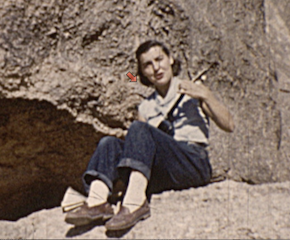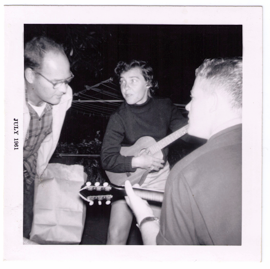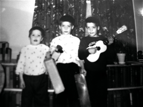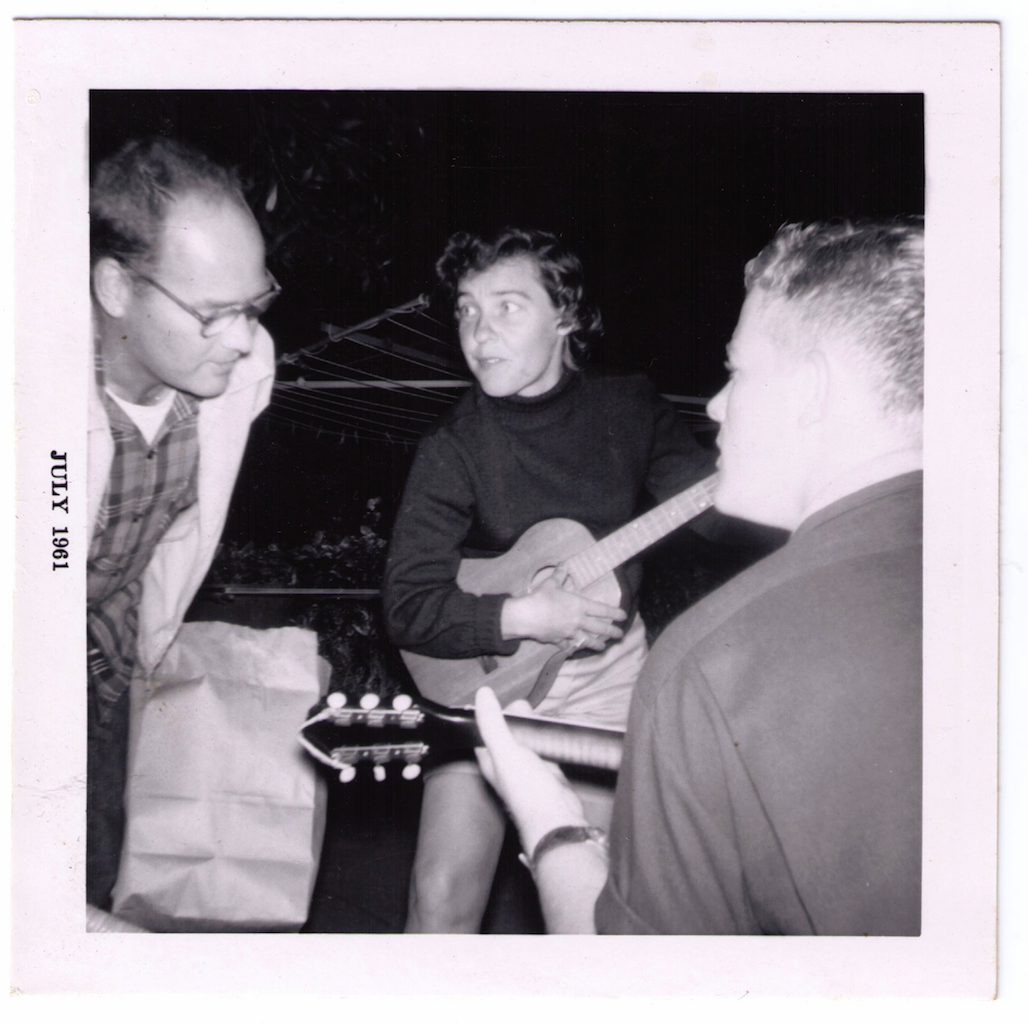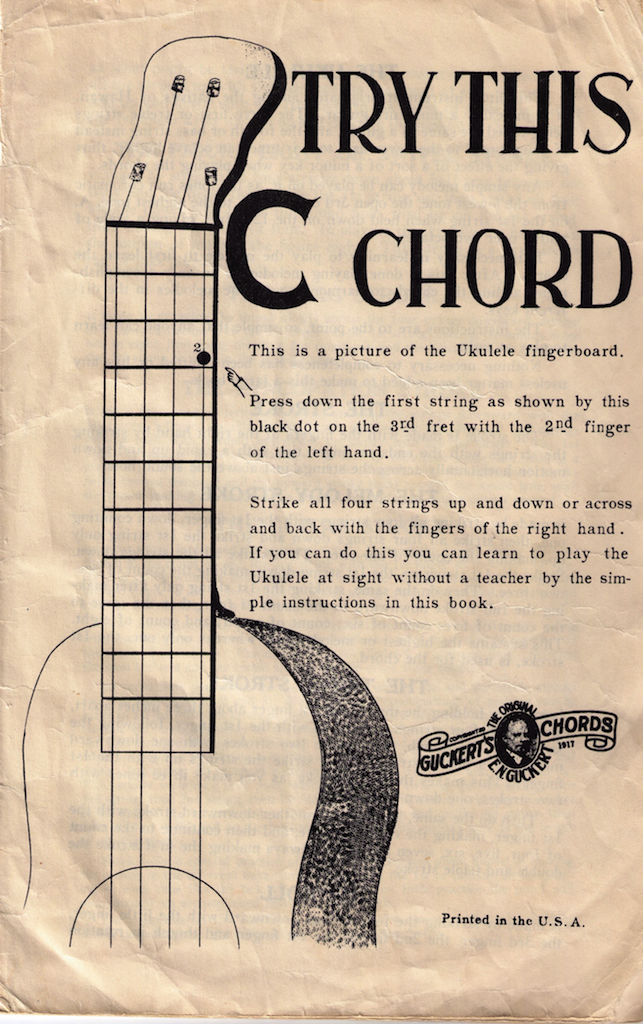Mi madre tocaba el ukelele y tal como sus niños ella tenía uno de plástico. Se podía tocar esos instrumentos pero en realidad eran como juguetes. Había un ukelele de madera en la tienda de música no muy lejos de nuestra casa. Era un barítono que costaba 40 dólares, muchísimo dinero en aquel entonces. Ella tenía muchas ganas de tenerlo.
Cuando llegó la navidad todos creímos que mi padre le regalaría a mi madre el ukelele de madera pero en lugar del instrumento le compró un reloj carísimo.
Un día oí a mi padre decir arrepintiéndose:
—Yo debería haberle comprado el ukelele
en la navidad.
Yo posiblemente haya oído eso en el cumpleaños de mi madre en marzo. Mi padre debe de habérselo comprado como regalo de cumpleaños y me hace sentir feliz creer esto porque así ella no debe de haber tenido que esperar mucho tiempo para tener lo que quería.
La siguiente foto fue tomada en julio de 1961. Por eso ella ya podría haber tenido el instrumento por cuatro meses.
Mi madre tocando el ukelele barítono en 1961. Mi tío, Mole Cole, está a la izquierda. No sé quién es el guitarrista.
Mi tío Mole les había enseñado a sus sobrinos a tocar y puede ser que él le enseñó a mi madre también. No podría haber sido mi padre: él era un pianista maravilloso y podía tocar la trompeta, pero no tocaba el ukelele. Sé que también mi madre tenía un manual de instrucciones sobre el ukelele y todavía lo tengo en casa.
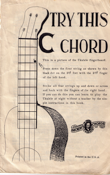
El manual de instrucciones de mi madre
En mi ensayo “los jinetes” de este libro cuento algo importante que dijo mi héroe de música, el Ranger Doug. Al enseñar su método de tocar acordes de solamente tres cuerdas dijo:
—Más sencilla, más elocuente.
Bueno. El ukelele se construye así en la fábrica. Cuenta con solamente cuatro cuerdas y por eso para mí el sonido resultante es limpio, rico, y sofisticado. Siempre he dicho que es el instrumento más subestimado de todos. En los años 20, 30, y 40 la partitura de canciones muy a menudo incluía los acordes para el ukelele. Aun las más respetadas composiciones de jazz llevaban acordes para ukelele.
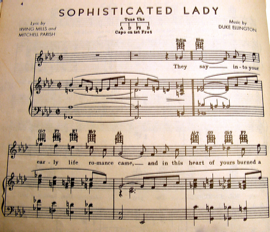
“Sophisticated Lady” por Duke Ellington con acordes de ukelele de mi colección. Incluso se enseña a afinar el instrumento. Esa es una de mis canciones predilectas y la toco en el piano. No sé por qué pero cuando sueño que estoy tocando el piano esta es la canción que siempre toco.


Detalle de la partitura
George Harrison, el guitarrista de los Beatles estaba loco por este instrumento y Paul McCartney aún hoy siempre lleva al escenario su ukelele por lo menos una vez durante sus espectáculos. Cuando George se murió, Joe Brown tocó la canción “I’ll See You in My Dreams” por Gus Kahn y Isham Jones en el servicio de conmemoración. El arreglo, tomado directamente de la partitura de 1924 es increíble.
Hace dos años una muchacha española que yo conozco me invitó varias veces a tocar con ella. Ella tocaba el ukelele. Llevaba a una amiga que también tenía un ukelele. Ella tocó el mismo arreglo de Gus Kahn en la clave de Fa exactamente como lo había hecho Joe Brown.
Pero he divagado.
Un día, de niño, le pregunté a mi madre:
—¿Estabas decepcionada cuando no recibiste el ukelele en la navidad?
Contestó alegremente:
—Bueno, yo creo que un poquito tal vez. Pero ahora estoy contenta de tener el reloj.
Ella muchas veces cantaba la canción caribe “Maryanne.” Siempre recuerdo la canción y siempre me ha gustado. En el año 2006 yo grabé una versión con armonía de tres partes.
Mis hermanos y yo. Soy yo en la parte central de la foto.
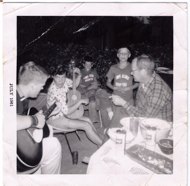
Otra sesión con el ukelele
Cuando mencioné a mi hermana que pensaba escribir de nuestra madre y su ukelele ella dijo:
—Me acuerdo del ukelele muy bien. Recuerdo también que un día ella dejó de cantar. Nunca volvió a cantar más y no estoy segura por qué.
Era cierto. Ahora que lo pienso yo de niño también sabía que ella había dejado de cantar y sí creo que esto pasó de súbito. ¿Por qué? Tampoco lo sé yo.
El ukelele barítono se quedó en un anaquel — el ropero de la recamara de mis padres — por muchos años. Me pregunto por dónde habrá ido. Me pregunto por qué mi madre dejó de tocarlo. Puede ser que nada más se cansó del instrumento.
28: My Mother’s Ukulele
My mother played the ukulele and like her kids she had a plastic one. You could play those instruments but in reality they were like toys. There was a wooden ukulele in the music store not far from our house. It was a baritone that cost 40 dollars, a lot of money back then and she really wanted to have it.
When Christmas came, we all thought that my dad was going to buy my mom the wooden ukulele, but instead of the instrument he bought her a really expensive watch.
One day I heard my father saying regretfully: “I should have bought her the uke for Christmas.”
I might possibly have heard this on my mom’s birthday in March. My father must have bought it for her as a birthday present and and it makes me feel happy to think that because that way she must not have had to wait very long to get what she wanted.
The following photo was taken in July of 1961. Therefore she already must have had the instrument for four months.
My mother playing the baritone ukulele in 1961. My uncle, Mole Cole, is on the left. I don’t know who the guitar player is.
My uncle Mole had taught his nephews to play and it could be that he taught my mother as well. It couldn’t have been my father: he was a fantastic piano player and could play the trumpet, but he didn’t play the ukulele. I also know that my mom had an instructional book on the ukulele and I still have it at home.
My Mom’s Instructional Book
In my essay “The Riders” in this book I tell about something important that my musical hero, Ranger Doug said as he was teaching his method of playing guitar chords with only three notes.
“Less is more.”
Ukuleles are made in factories. They come with only four strings and so for me the resulting sound is clean, rich, and sophisticated. I’ve always said that the ukulele is the most underrated instrument of all. In the 20s, 30s, and 40s sheet music quite often included ukulele chords. Even the most respected jazz compositions came with chords for the ukulele.
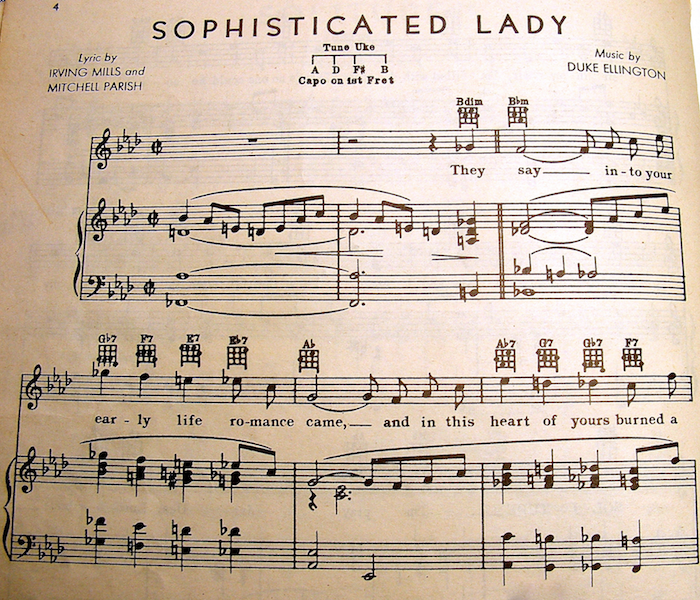
“Sophisticated Lady” by Duke Ellington with ukulele chords from my collection. They even show you how to tune the instrument. This is one of my favorite songs and I play it on the piano. I don’t know why, but when I dream I’m playing piano, this is the song I always play.
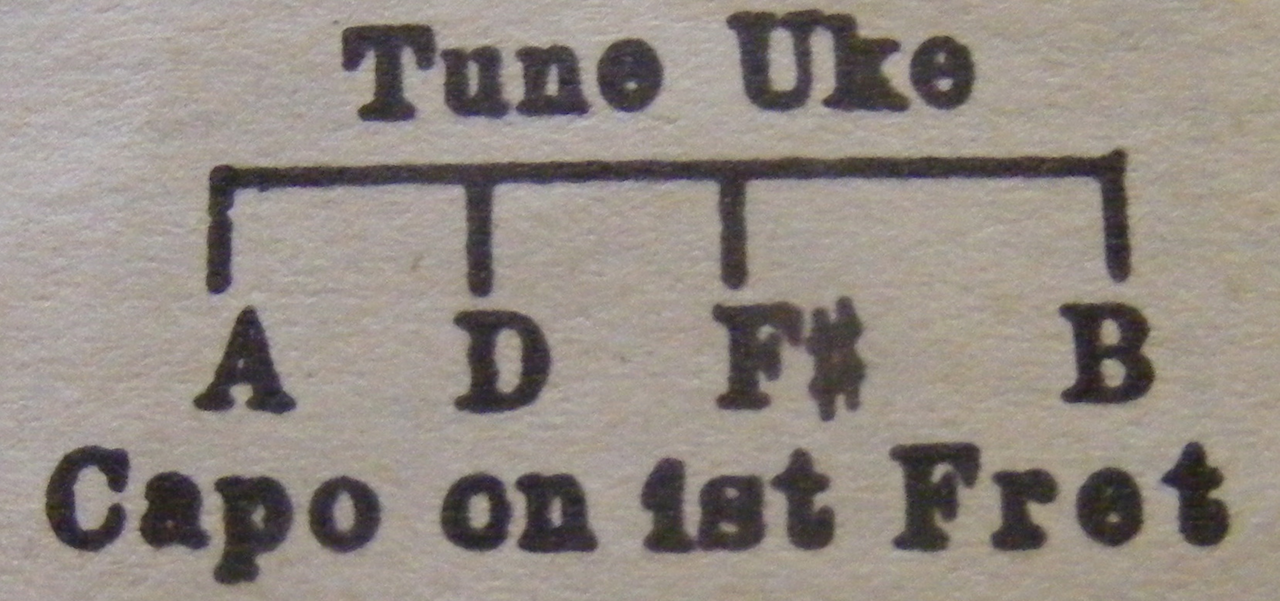
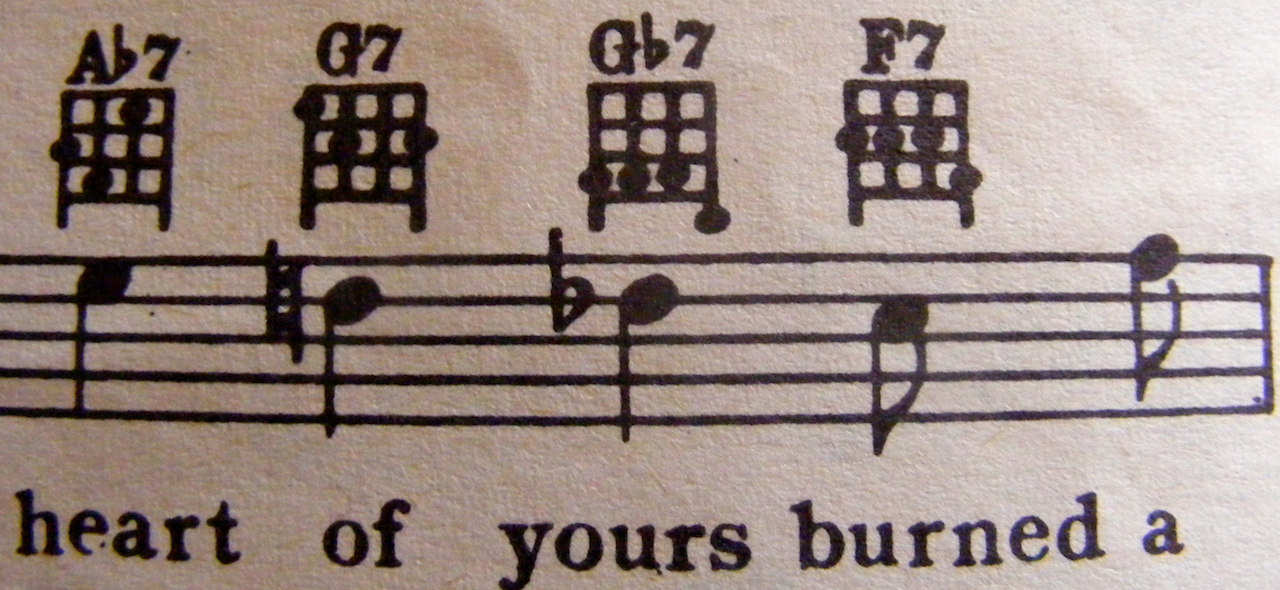
Sheet Music Detail
George Harrison, the guitarist in the Beatles, was crazy about that instrument y Paul McCartney even today always brings his uke on stage at least once during one of his shows. When George died, Joe Brown played “I’ll See You in My Dreams” by Gus Kahn and Isham Jones at the memorial service. The arrangement, taken directly from the 1924 sheet music, is incredible.
Two years ago, a Spanish girl that I know invited me over a few times to play with her. She played the ukulele. She brought along a friend that also had a uke. She played the same arrangement by Gus Kahn en the key of F exactly as Joe Brown had done.
But I digress.
One day as a kid, I asked my mom, “Were you disappointed when you didn’t get the ukulele on Christmas?”
“Well, I guess I was a little perhaps,” she answered cheerfully. “But now I’m happy to have the watch.”
She often played the song “Maryanne.” I always have remembered the song and I’ve always liked it. In 2006, I recorded a version with three-part harmony.

My brothers and I. I’m in the middle of the picture.
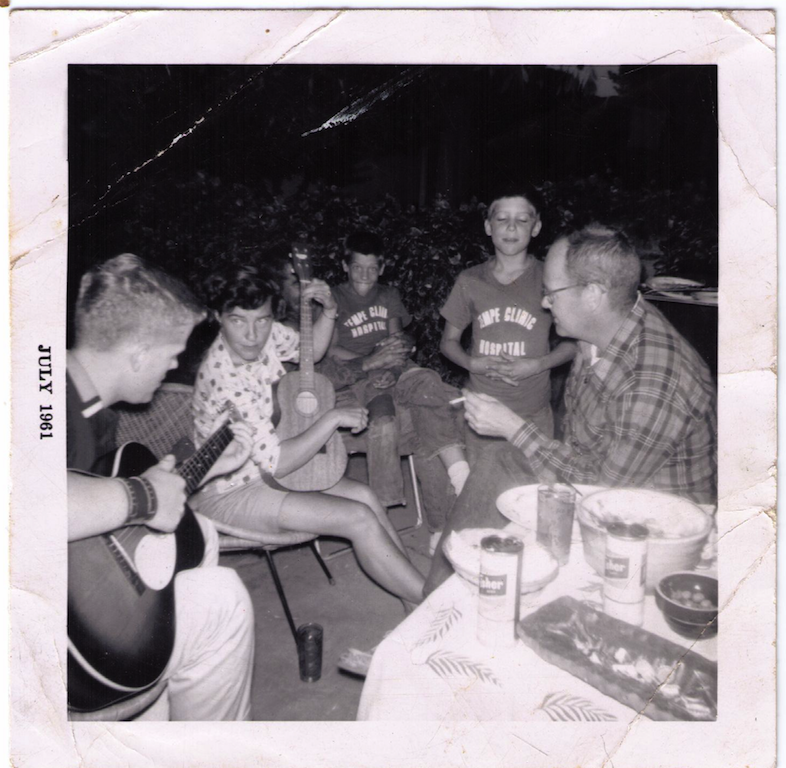
Another session with the ukulele
When I mentioned to my sister that I was thinking of writing about our mother and her ukulele she said, “I remember the uke really well. I also remember that one day she stopped playing. She never played again and I’m not sure why.”
It was true. Now that I think of it, as a kid I also knew that she had stopped singing and, yes, I think that it happened suddenly. Why? I don’t know either.
The baritone uke stayed in a closet—the clothes closet in my parents’ bedroom— for many years. I wonder where it could have gone. I wonder why my mom stopped playing it. It could be that she just got tired of the instrument.
